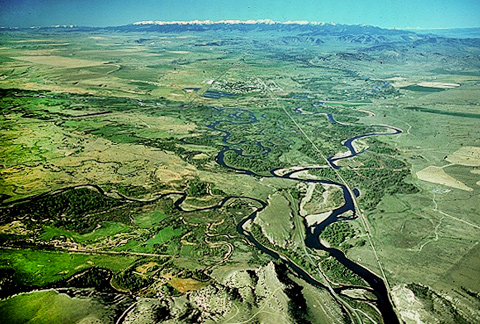The Missouri Headwaters by Air
View southwest, upstream
To see labels, point to the image.
© 2000 Airphoto—Jim Wark.
For thousands of years, Indian travelers had mapped the geography of North America in their collective minds. Appreciating this resource, Lewis and Clark had been the Mandans‘ avid students throughout the winter at Fort Mandan. One feature the Indians described was the coming together of “three noble rivers.” Upon the Corps’s arrival at this confluence on 25 July 1805, Lewis quickly recognized it as “an essential point in the geography of this western part of the Continent.”
The Madison and Jefferson rivers, which the captains named for the Secretary of State and “the author of our enterprise,” respectively, converge at the sandbars just to the right of center in the picture. The Gallatin River, named for secretary of the Treasury Albert Gallatin, meets them at bottom left. At the center of the horizon are the Tobacco Root Mountains. To their left are the more distant Madison and Gravelly Ranges. Interstate 90 etches its way across the center of the photo, and an abandoned railroad bends toward the town of Three Forks, Montana, established in 1908. Farther in the distance, near the center of the picture’s right edge is the place where, only four years before, Hidatsa warriors took Sacagawea captive, effecting her destiny as an immortal American icon.
Eastbound on 13 July 1806, Clark and his twenty-two-man contingent, along with Sacagawea and seventeen-month-old Pomp, wended their way through here again. From the confluence Sergeant Ordway led ten men in five canoes down the Missouri to the Upper Portage Camp above the Great Falls, while Clark and the remaining party of thirteen, including the Charbonneaus and their son, headed overland to explore the Yellowstone River.
See also Three Forks of the Missouri.
From Discovering Lewis & Clark from the Air
Photography by Jim Wark
Text by Joseph Mussulman
Reproduced by permission of Mountain Press
Experience the Lewis and Clark Trail
The Lewis and Clark Trail Experience—our sister site at lewisandclark.travel—connects the world to people and places on the Lewis and Clark Trail.
Discover More
- The Lewis and Clark Expedition: Day by Day by Gary E. Moulton (University of Nebraska Press, 2018). The story in prose, 14 May 1804–23 September 1806.
- The Lewis and Clark Journals: An American Epic of Discovery (abridged) by Gary E. Moulton (University of Nebraska Press, 2003). Selected journal excerpts, 14 May 1804–23 September 1806.
- The Lewis and Clark Journals. by Gary E. Moulton (University of Nebraska Press, 1983–2001). The complete story in 13 volumes.


